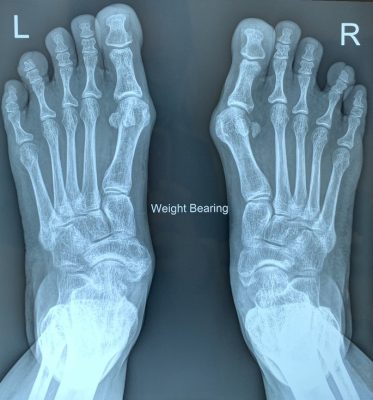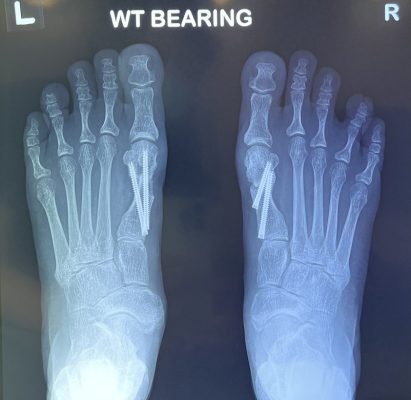Bunions, medically known as hallux valgus, are bony bumps that form at the base of the big toe joint. They develop when the big toe pushes against the adjacent toe, causing the joint to protrude and bend towards the other toes. Bunions can be painful and may cause difficulty in finding comfortable footwear.


The exact cause of bunions is often a combination of genetic factors and wearing ill-fitting shoes. Factors that can contribute to the development of bunions include:
Foot structure: Certain foot shapes and structures can make individuals more prone to developing bunions such as flat feet
Genetics: If bunions run in your family, you may have an increased risk of developing them.
Improper footwear: Wearing tight, narrow shoes or high heels can squeeze the toes together and contribute to the development of bunions.
Medical conditions: Some conditions, such as rheumatoid arthritis, can increase the likelihood of developing bunions as the inflammation damages the ligaments that hold the toe in a normal position.
Treatment options for bunions vary depending on the severity of the condition and the level of discomfort experienced. Here are some common approaches:
Non-surgical treatments:
Wearing wider and more comfortable shoes: This can help reduce pressure on the bunion and alleviate pain.
Using bunion pads or cushions: These can provide a protective barrier between the bunion and the shoe, reducing friction and pain.
Applying ice packs: Cold therapy can help reduce inflammation and relieve pain.
Taking over-the-counter pain relievers: Nonsteroidal anti-inflammatory drugs (NSAIDs) may help alleviate pain and reduce inflammation.
Orthotic devices:
Custom shoe inserts or orthotic devices can help redistribute pressure on the foot, providing relief from bunion pain and preventing further progression.
Bunion splints or braces:
These devices are worn at night and can help realign the toe joint and slow down the progression of the bunion.
Physical therapy:
Exercises and stretches prescribed by a physical therapist can help strengthen the muscles and improve the alignment of the foot.
Corticosteroid injections:
In some cases, a doctor may recommend corticosteroid injections to reduce inflammation and provide temporary pain relief.
Surgical options:
If non-surgical treatments do not provide sufficient relief or the bunion is severe, surgery may be considered. The specific surgical procedure will depend on the individual case, but the goal is usually to realign the joint, remove the bony prominence, and correct any deformities.
Modern techniques have allowed surgeons to use special instruments and minimally invasive options to allow bunion correction with percutaneous and tiny incisions which allows for less postoperative pain and swelling and decreased risk of bunion recurrence. Dr Ananda is trained in minimally invasive bunion correction.





